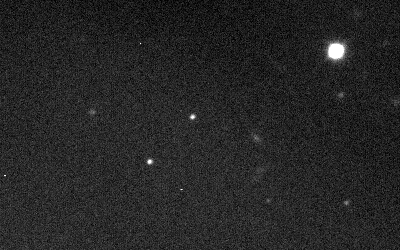Ymir (moon) on:
[Wikipedia]
[Google]
[Amazon]
Ymir , or Saturn XIX, is the second-largest retrograde irregular moon of Saturn. It was discovered by 
MPEC 2000-Y15: S/2000 S 1, S/2000 S 2, S/2000 S 7, S/2000 S 8, S/2000 S 9
(2000 Dec. 19 ephemeris)
(by
Ymir website
(by Tilmann Denk) Astronomical objects discovered in 2000 Discoveries by Brett J. Gladman Irregular satellites Moons of Saturn Norse group Ymir Moons with a retrograde orbit {{astronomy-stub
Brett J. Gladman
Brett James Gladman (born April 19, 1966) is a Canadian astronomer and a full professor at the University of British Columbia's Department of Physics and Astronomy in Vancouver, British Columbia. He holds the Canada Research Chair in planetary as ...
, et al. in 2000, and given the temporary designation S/2000 S 1. It was named in August 2003 after Ymir
In Norse mythology, Ymir (, ), also called Aurgelmir, Brimir, or Bláinn, is the ancestor of all jötnar. Ymir is attested in the ''Poetic Edda'', compiled in the 13th century from earlier traditional material, in the ''Prose Edda'', writ ...
, who in Norse mythology
Norse, Nordic, or Scandinavian mythology is the body of myths belonging to the North Germanic peoples, stemming from Old Norse religion and continuing after the Christianization of Scandinavia, and into the Nordic folklore of the modern period ...
is the ancestor of all the Jotuns or frost giants.
It takes 3.6 Earth years to complete an orbit around Saturn. Of the moons that take more than 3 Earth years to orbit Saturn, Ymir is the largest, at about in diameter; Ymir is also the second largest member of the Norse group
The Norse group is a large group of retrograde irregular satellites of Saturn. Their semi-major axes range between 12 and 24 Gm, their inclinations between 136° and 175° and their eccentricities between 0.13 and 0.77. Unlike for the Inuit ...
, after Phoebe.
Spectral measurements from ''Cassini–Huygens
''Cassini–Huygens'' ( ), commonly called ''Cassini'', was a space research, space-research mission by NASA, the European Space Agency (ESA), and the Italian Space Agency (ASI) to send a space probe to study the planet Saturn and its system, i ...
'' show that Ymir is reddish in color, unlike Phoebe's gray color, suggesting a separate origin for this moon. It shows a similar light curve
In astronomy, a light curve is a graph of light intensity of a celestial object or region as a function of time, typically with the magnitude of light received on the y axis and with time on the x axis. The light is usually in a particular frequ ...
as Siarnaq
Siarnaq, also designated Saturn XXIX, is the second-largest irregular moon of Saturn. It was discovered on 23 September 2000 by a team of astronomers led by Brett J. Gladman. It was named after the Inuit goddess of the sea, Siarnaq, who is more ...
and has a triangular shape, rotating in a retrograde direction about once every 11.9 hours.

References
External links
MPEC 2000-Y15: S/2000 S 1, S/2000 S 2, S/2000 S 7, S/2000 S 8, S/2000 S 9
(2000 Dec. 19 ephemeris)
(by
Scott S. Sheppard
Scott Sander Sheppard (born 1977) is an American astronomer and a discoverer of numerous moons, comets and minor planets in the outer Solar System.
He is an astronomer in the Department of Terrestrial Magnetism at the Carnegie Institution for Scie ...
)
Ymir website
(by Tilmann Denk) Astronomical objects discovered in 2000 Discoveries by Brett J. Gladman Irregular satellites Moons of Saturn Norse group Ymir Moons with a retrograde orbit {{astronomy-stub